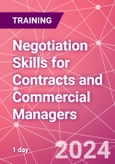This highly interactive course emphasises why it is so important to engage in the battle of the forms and achieve agreement between the contracting parties. It explains how a well-negotiated contract can add value and minimise exposure to potential risks and later disputes/litigation. It also covers how a well-negotiated contract can add value and strengthen a long-term relationship, developing collaboration to realise opportunities and make the management of projects easier, with fewer risks and less delays.
This course will give delegates the methodology to prepare for negotiation in a thorough, comprehensive and structured manner, and enable them to have clarity in what they aim to achieve from the negotiation and identify the best approach.
This course combines theory with practical application, giving delegates structure to how they approach a contract negotiation so that they are fully informed, which in turn instills confidence ready to achieve results.
This course will look at the content of the negotiation and the process of the negotiation, without the use of legal jargon.
Benefits of attending
By attending this course you will develop your skills to:
- Plan the best way to prepare for a negotiation
- Understand how to add value and minimise exposure to risks
- Get to grips with the best techniques to achieve positive outcomes
- Learn how to build and sustain relationships with key stakeholders
- Use best practice techniques to undertake the negotiation
- Evaluate outcomes and reach formal written agreement
Certifications:
- CPD: 6 hours for your records
- Certificate of completion
Course Content
Introduction
Course Provider

Ms Catherine Hurst,
Consultant & Trainer ,
Falconbury LtdCatherine Hurst is an independent commercial consultant and trainer. She was formerly a Commercial Manager at BAe Systems, following previous contract and commercial roles with GEC and Siemens, and has extensive practical experience of contract management, contract negotiation, commercial risk management and bid management.
She has been providing public training courses and in-house training courses for more than 10 years. Her success is demonstrated by the long standing relationship she has developed with numerous clients, to whom she provides regular repeats of her in-house courses.
Her training clients cross all sectors, including commercial companies, the government sector and charities. She is a highly experienced and a very popular trainer. Her style and manner of training brings the subject matter to life, making it enjoyable and easy to understand for all.
Who Should Attend
All those who need to gain the latest knowledge and skills to succeed in negotiating contracts, including:
- Contracts and commercial managers and engineers
- Business development managers
- Project and procurement managers
- All those involved in the negotiation and management of commercial business contracts








